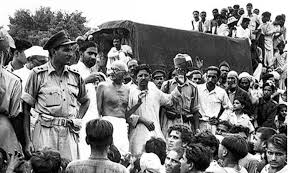On April 10, 2017, an exhibition titled “Swachhagraha – Bapu Ko Karyanjali – Ek Abhiyan, Ek Pradarshani” inaugurated by PM Narendra Modi at National Archives of India (NIA) in New Delhi. This exhibition has been organised to mark 100 years of Champaran Satyagraha, which was Mahatma Gandhi’s first experiment in using non-violence and non-cooperation as methods to protest.
- PM Modi also launched an ‘Online Interactive Quiz’ at the event, which will continue for 30 months till October, 2019 coinciding with 150th birth Anniversary of Mahatma Gandhi.
- The exhibition will feature several sections highlighting the key events that took place during Champaran Satyagraha. Digital tools such as video walls and projectors will be used to engage the visitors.
Satyagraha & Swachhagraha:
Ganhiji was an ardent advocate of cleanliness. This exhibition is an attempt to reinterpret ‘Satyagraha’ in the current context by emphasising the value of cleanliness through the term ‘Swachhagraha’. Accomplishments under ‘Swachh Bharat Abhiyan’ in areas of hygiene and sanitation will be elaborately displayed at the exhibition.
Venkaiah Naidu releases book ‘Gandhi in Champaran’ in Delhi
M Venkaiah Naidu – Minister for Information & Broadcasting, released following three heritage books to mark 100 years of Champaran Satyagraha:
1.’Gandhi in Champaran’ – This book provides vivid description of Mahatma Gandhi’s experiences in Champaran
2.‘Romain Rolland and Gandhi Correspondence’ – This book is a collection of letters exchanged between Nobel Literature Prize Winner Romain Rolland and Mahatma Gandhi
3.“Mahatma Series (8 volumes)” – This book is a biographical account of Mahatma Gandhi
All three books have been written by renowned author DG Tendulkar and have been published by Publications division under Union Ministry of Information & Broadcasting.
Quick Facts about Champaran Satyagraha:
On April 10, 1917, Mahatma Gandhi arrived in Champaran district of Bihar after being briefed by one of his associates about the plight of indigo farmers in Champaran.
- By conducting surveys through volunteers, Gandhiji realised that farmers in Champaran were forced to grow indigo and other cash crops by British East India Company. Due to this, farmers were not able to grow food crops required for their survival. Moreover they
 were not adequately compensated for the same. Added to this were the harsh taxes which were collected even during famines.
were not adequately compensated for the same. Added to this were the harsh taxes which were collected even during famines. - Gandhiji was disturbed to see such sub-human plight of Champaran farmers. As a solution he decided to take on the government by means of non-cooperation with Govt. officials. This was done without resorting to any form of violence.
- Very soon Gandhiji gained popular support and the entire movement for farmers’ rights now turned into a mass movement. Eventually British officials had to concede to his demands and provided relief to Champaran farmers.
The Champaran Satyagraha is one of the key events in India’s struggle for independence. It brought Gandhiji to the centre stage of national movement and Indian masses started adopting his unconventional methods of protest.





